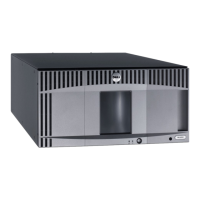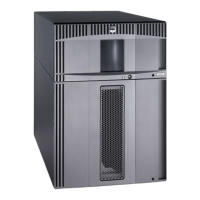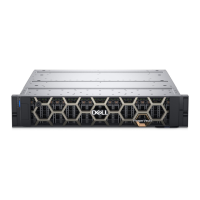Getting Information
file:///T|/htdocs/stor-sys/ML6000/en/html/ch06.htm[9/17/2012 1:49:55 PM]
The Network Settings report provides information on the following library network settings:
• Network — host name, primary DNS, alternate DNS.
• IPv4 Settings — Dynamic Host Configuration Protocol (DHCP) enabled/disabled, IP address, gateway address, and
net mask.
• IPv6 Settings (if IPv6 is enabled) — DHCP enabled/disabled, Stateless enabled/disabled, Static enabled/disabled,
network prefix, gateway, and all IPv6 addresses.
• SSL — SSL, port, and cipher of the library.
• SMI-S — access and state enabled/disabled settings of the library.
• Access: indicates whether the SMI-S port for SMI-S traffic to the library (port 5988) is enabled or disabled. You
can change the setting via the operator panel, Tools > Security menu. The default setting is enabled.
• State: indicates whether allowing SMI-S to run on the library is enabled or disabled. You can change this setting
on the operator panel, Tools > System Settings. The default is disabled.
• SNMP — access enabled/disabled, V1 enabled/disabled, V2 enabled/disabled, V3 enabled/disabled, algorithm,
encryption enabled/disabled, and port.
• SNMP-Traps — IP addresses and ports.
The path to open the report from the Web client is Reports > Network Settings.
Viewing Logged-In Users
The User Login report contains information about the users that are currently logged into the library. The report contains the
following information:
• User name — Name of logged-in user.
• Role name — Privilege level of logged-in user (for example, Admin for administrator, User for non-administrator,
non-service user).
• Login date and time — Date and time the user logged into the library.
• Last activity date and time — Date and time the user last logged into the library.
• Login location — IP address or host name of the system being used to access the system.
• Management interface — User interface being used to access the system (Web client or operator panel).
The path to open the report from the Web client is Reports > Logged in Users.
Viewing Slot Information
The All Slots report contains information on all slots that are currently assigned to a partition and all I/E slots. A maximum of
20 responses displays per page. You can scroll between the pages using the page arrows at the bottom left of the screen. The
report contains the following information about each slot:
• Slot type — drive, I/E station, cleaning, or storage slot.
• Barcode — barcode number of the cartridge installed in the slot (no barcode number means the slot is empty).
• Partition — the partition that owns the slot.
• Location — location coordinates of the slot.
• Element Address — element address of the slot.
• Encryption — the encryption state of the media in the slot. In order for the library to know the encryption state, the
tape must have been placed into an encryption-capable tape drive in the library. The encryption-capable tape drive
reads and records the encryption state of the tape, and the encryption state displays as "Encrypted" or "Not
Encrypted." If the tape was not placed into an encryption-capable tape drive in the library, or if the slot is empty, the
encryption state displays as "Unknown."
•
Get Count
— the number of times the picker successfully removed a tape from the slot.
•
Get Retries
— the number of times the picker had to perform a recovery operation to remove a tape from
the slot.
•
Put Count
— the number of times the picker successfully placed a tape into the slot.

